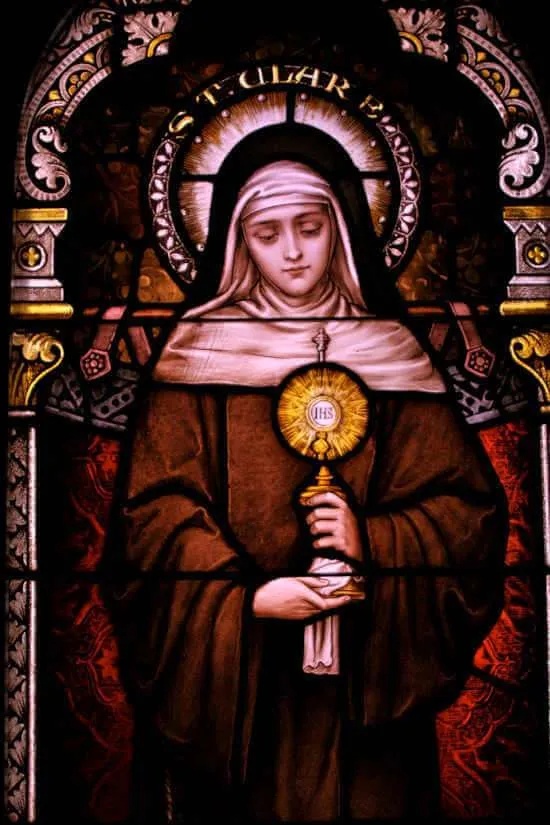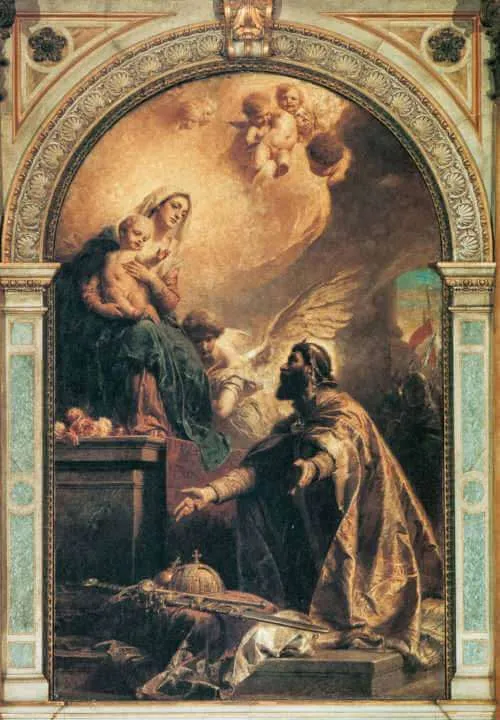c. 1193–1253; Patron Saint of the Poor Clares, embroiderers, goldworkers, laundry workers, needleworkers, telephones, and television; Invoked against eye diseases and for good weather; Canonized by Pope Alexander IV in 1255
Clare Offreduccio, born to a high-ranking noble family in the quaint Italian town of Assisi, was the eldest of three daughters. Raised in a grand palace in Assisi and a castle on the nearby slope of Mount Subasio, the girls were nurtured in their faith by their devout Catholic parents, especially their mother. From an early age, they led a life of prayer.
When Clare was twelve, her parents, adhering to the customs of the time, intended to arrange a marriage for her with a wealthy nobleman. However, Clare expressed her desire to wait until she turned eighteen, to which her parents agreed.
As a teenager, Clare grew to admire a twenty-four-year-old man named Francis, who had recently undergone an intense conversion. In his youth, Francis had been the life of the party in Assisi, aspiring to become a great knight—a dream he chased twice. His life took a turn when he was captured in war and subsequently imprisoned for a year. Upon being ransomed by his father, Francis returned to Assisi as a changed man. His ordeal ignited a spiritual transformation that would eventually influence not only his life but also that of Clare, the town of Assisi, and the entire Church for centuries to come. After renouncing his family inheritance and receiving papal approval, Francis and a small group of followers adopted a radical lifestyle, marked by poverty, prayer, penance, and itinerant preaching.
Around 1211 or 1212, when Clare was nearing her eighteenth birthday, she attended a Lenten mission at the church of San Giorgio in Assisi, preached by Brother Francis. The mission resonated deeply with Clare, and she felt God calling her to join Francis and his brothers by forming a women’s branch of their new order. Aware that her family would not approve of her decision, Clare spoke to Brother Francis in secret. With the local bishop’s approval, Francis agreed to welcome her on Palm Sunday evening at the small chapel of the Portiuncula where his order was staying.
That night, Clare arrived at the chapel, dressed as a bride ready to wed her spouse. She was accompanied by her aunt and a friend. Clare surrendered her noble attire for a coarse habit, allowed Brother Francis to cut her long hair, and covered her head with a veil. Francis then arranged for her to stay at a nearby Benedictine convent.
Upon discovering Clare’s decision, her family tried to convince her to return home, making promises of wealth and all the privileges of nobility. Clare refused. When they attempted to force her to return, she resisted, clung to the altar, and showed them her cut hair, a symbol of her dedication to God. Realizing they no longer held authority over her, her family reluctantly backed down. This marked not only a pivotal moment in Clare’s life but also the birth of the religious order of the Poor Clares.
For her safety and peace of mind, Clare was moved to another monastery a few days later, and then to another. To her surprise, her sister Caterina joined her a few weeks later. Their family attempted to intervene again, trying to force Caterina to leave, but Clare’s prayers triumphed. As one story goes, due to Clare’s prayers, Caterina’s body became so heavy that the men could not lift her. Eventually, her family gave up. Caterina was accepted into the newly formed order and was given the religious name Agnes.
In time, even their other sister and mother joined Clare and Agnes at the small house that Brother Francis had built for them next to the church of San Damiano. Under the rule for their new life given by Brother Francis, they became known as the Poor Ladies of San Damiano. Only after Clare’s death did they become known as the Poor Clares.
The Poor Ladies of San Damiano led a life of extreme poverty, manual labor, and almost complete silence under the rule of Brother Francis, which they strictly followed for the first few years. Unlike the friars, the Poor Ladies remained cloistered, instead of traveling and preaching. At that time, their severe austerity was new to religious women, as most convents were wealthy and owned large amounts of land tended by others for their needs. This newly formed order, like the Franciscan friars, was groundbreaking in its vocation, particularly its strict rule of poverty.
Despite her reluctance to assume any form of authority or title, Clare was made the abbess of the community in the following years. She was humble and shy, and found giving orders challenging. She often took up the most menial and unwanted chores.
God’s protection shielded the new order. When Muslim invaders surrounded the convent, preparing to attack Assisi, Clare, upon hearing of their presence, went to the chapel and took the monstrance with the Blessed Sacrament to confront them. Overwhelmed, the invaders retreated and never returned.
Mother Clare spent most of her life battling bishops, cardinals, and even popes who wished her order to align more with mainstream Benedictine nuns. Unyielding, she chose to depend on divine providence, trusting completely in her divine Spouse. These struggles intensified after the death of her spiritual father and brother, Saint Francis, in 1226. After many years of battling, Mother Clare wrote a rule for her sisters and received approval of that rule from Pope Innocent IV, mere days before her death in 1256 at the age of fifty-nine. This marked the first time in history that a woman wrote a rule for religious life that was formally approved. Despite her hidden life, Saint Clare’s holiness was widely known, so much so that the pope came to Assisi to celebrate her funeral. She was canonized just two years later.
As we honor Saint Clare and her sisters, we are especially invited to ponder their complete trust in God. It took great faith to abandon her noble life to embrace radical poverty, but she did so, remaining faithful to her calling. Through her, God has brought forth an abundance of good fruit that will only be fully understood in Heaven. Ponder Clare’s poverty, her hidden life of silence and continuous prayer, and her fidelity to God’s call. As you do, let her radicalness inspire you to step out of your own comfort zone and embrace a more trusting life of selfless service to God’s will.
Source: https://mycatholic.life/saints/saints-of-the-liturgical-year/august-11—saint-clare-virgin/








